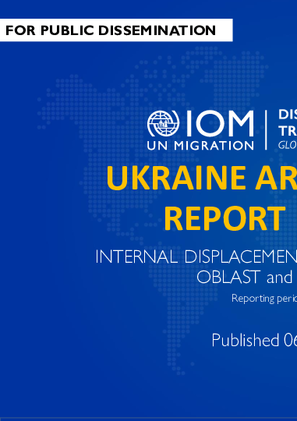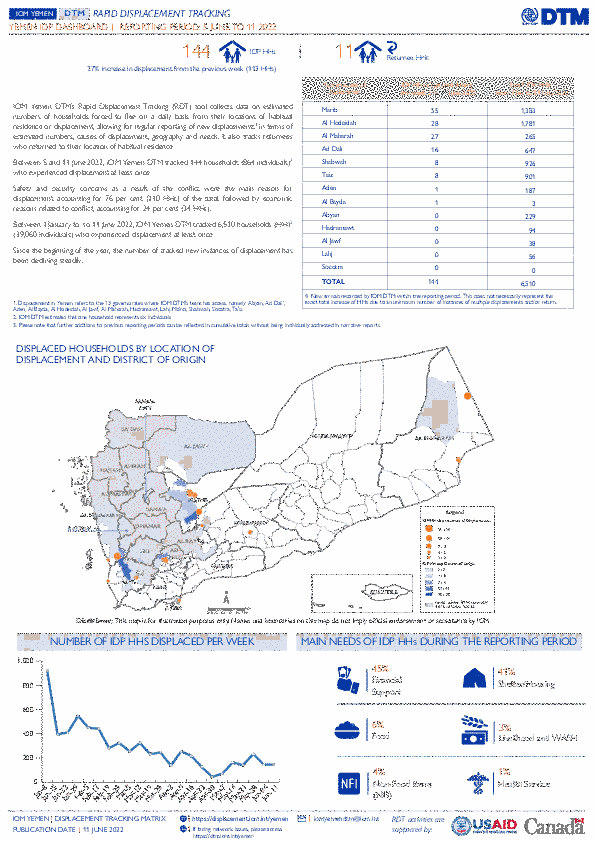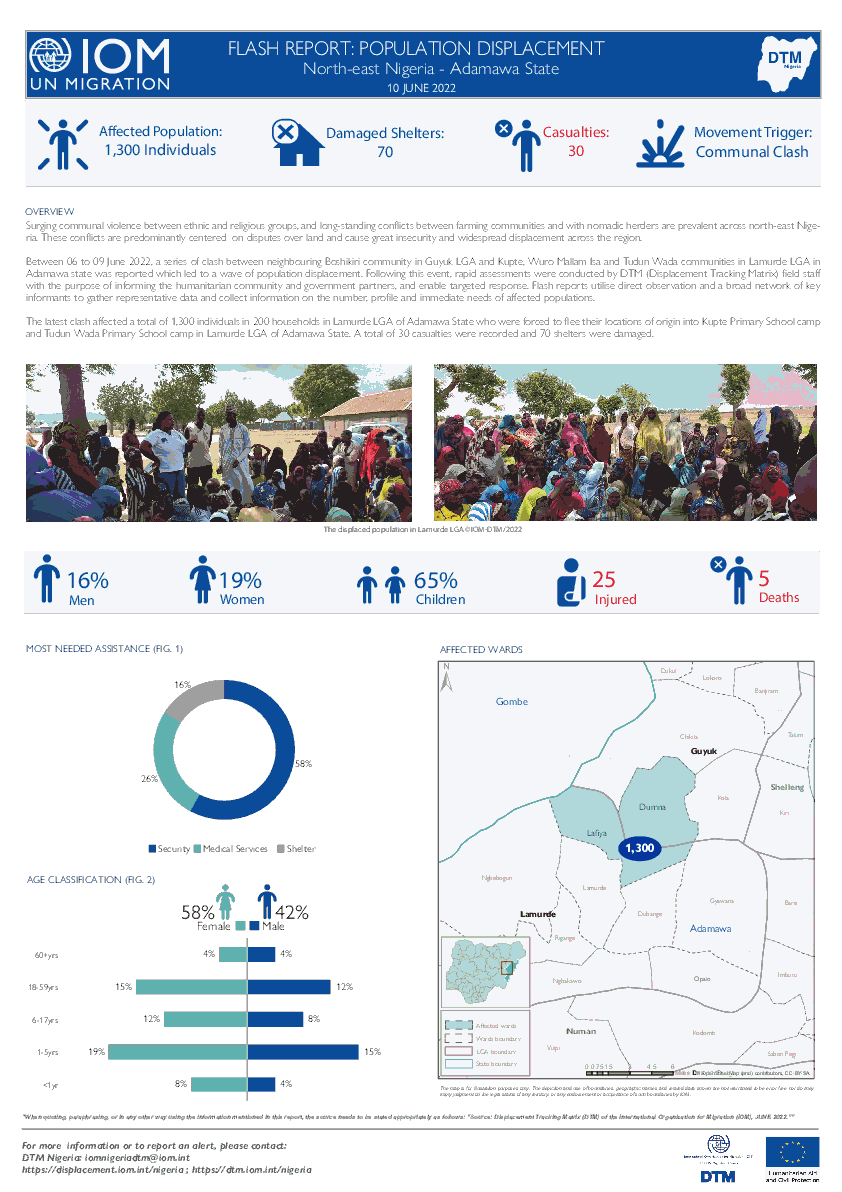-
Countries
-
Data and Analysis
-
Special Focus
-
Crisis Responses
Contact
SouthSudanDTM@iom.int
Location
South Sudan
Activity
- Flow Monitoring Survey
- Flow Monitoring
Period Covered
Feb 01 2022 -Feb 28 2022
Flow monitoring aims to derive quantitative estimates of the flow of individuals through specific locations and to collect information about the profile, intentions and needs of the people moving and to quantify highly mobile populations by providing a picture of complex mobility dynamics.
Population Groups
Survey Methodology
Unit of Analysis Or Observation
Type of Survey or Assessment
Keywords
Geographical Scope
Administrative boundaries with available data
The current dataset covers the following administrative boundaries

Contact
DTM South Sudan, SouthSudanDTM@iom.int
Language
English
Location
South Sudan
Period Covered
Feb 01 2022
Feb 28 2022
Activity
- Flow Monitoring
DTM’s Flow Monitoring Registry (FMR) surveys people on the move at key transit points within South Sudan (SSD) and at its borders. It provides an insight into mobility trends, migration drivers and traveller profiles to inform programming by humanitarian and development partners and by the government, complementing DTM’s monitoring of COVID-19 mobility restrictions. In total, 29 Flow Monitoring Points (FMPs) were active in February 2022, surveying internal flows and cross-border travel with Uganda (UGA), the Democratic Republic of Congo (DRC), Sudan (SDN), Ethiopia (ETH), Kenya (KEN) and the Central African Republic (CAR). The Bentiu IDP Camp Bus / Canoe Station and Rotriak (Lalop) FMPs temporarily opened to support Rubkona (Suksita) FMP, while activities at Malakal Bus Station continue to be suspended. Figures are only indicative of existing trends among respondents at the active FMPs since DTM does not have full coverage of cross-border or internal flows. Participation in the survey is voluntary and anonymous.
Please click here to access a summary dataset.

Contact
DTM Djibouti, DTMDjibouti@iom.int
Language
French
Location
Djibouti
Period Covered
May 01 2022
Jun 30 2022
Activity
- Flow Monitoring
Pendant le mois de mai 2022, 20 882 mouvements ont été observés aux points de suivi des flux (Flow Monitoring Points, FMP) à Djibouti, soit une moyenne journalière de 674 mouvements. Les flux migratoires ont augmenté de manière significative avec 28 pour cent par rapport au mois d’avril 2022, pendant lequel un total de 16 339 mouvements avaient été observés. Pour la première fois, ils ont dépassé les niveaux observés pendant la période antérieure à la pandémie de COVID-19 (entre mars 2019 et mars 2020, la moyenne journalière était de 654).
Sur ces 20 882 mouvements, 2 707 (13%) ont été observés à Obock dans la région côtière de Djibouti où les migrants traversent le golfe d'Aden vers la péninsule arabique le long de ce que l'on appelle la route de l'est. Par rapport à la période de janvier à mai 2021, les mouvements en provenance de l’Éthiopie ont fortement augmenté de 37% en 2022 (de 36 454 au cours des cinq premiers mois de 2021 à 49 764 pour la même période en 2022). Par ailleurs, 2 886 Éthiopiens sont revenus du Yémen depuis janvier 2022. En effet, au début de la pandémie de COVID-19, ces retours étaient principalement dûs aux restrictions de mouvement en vigueur au Yémen et en Arabie Saoudite. La progressive détérioration des conditions de vie au Yémen a ensuite également entraîné des retours spontanés de plus en plus nombreux. Une tendance à la hausse de ces retours a été observée depuis janvier 2022 à mars 2022 suivi d’une baisse en avril 2022 et mai 2022.

Contact
DTM Djibouti, DTMDjibouti@iom.int
Language
English
Location
Djibouti
Period Covered
May 01 2022
May 31 2022
Activity
- Flow Monitoring
In May 2022, 20,882 movements were observed at the Flow Monitoring Points (FMPs) in Djibouti, representing a daily average of 674 movements. Migration flows increased significantly with 28 per cent compared to the month of April 2022, during which a total of 16,339 movements had been registered. For the first time, migration flows exceeded pre-COVID-19 levels (between March 2019 and March 2020, the daily average was 654).
Of these 20,882 movements, 2,707 (13%) were observed in Obock. This coastal region of Djibouti is the main gateway for migrants going to and returning from the Arabian Peninsula. Migrants regroup at congregation points in the Obock region where they then cross the Gulf of Aden on boats along what is known as the Eastern route.
Compared to the period January to May 2021, movements from Ethiopia have increased sharply by 37 per cent in 2022 (from 36,354 in the first five months of 2021 to 49,764 for the same time period in 2022). In addition, 2,886 Ethiopians have returned from Yemen since January 2022. At the beginning of the COVID-19 pandemic, these movements were mainly due to mobility restrictions imposed in Yemen and Saudi Arabia. Subsequently, the progressive deterioration of living conditions in Yemen also triggered growing numbers of spontaneous returns. An increasing trend of these returns has been observed since January 2022.

Contact
DTMUkraine@iom.int
Language
Ukrainian
Location
Ukraine
Period Covered
May 16 2022
May 31 2022
Activity
- Baseline Assessment
Починаючи з 24 лютого 2022 року війна в Україні спричинила безпрецедентну гуманітарну кризу в усіх адміністративних підрозділах (областях) країни. З 16 по 31 квітня Міжнародна організація з міграції (МОМ) провела базову оцінку території 521 громад, які приймають зареєстрованих внутрішньо переміщених осіб у Закарпатській, Львівській, Івано-Франківській,
Чернівецькій, Хмельницькій, Вінницькій, Житомирській,Кіровоградській та Полтавській областях, щоб отримати початкове уявлення про внутрішнє переміщення.
Проведення цієї рутинної оцінки підтримує цільове призначення та надання гу манітарної допомоги постраждалим населенням і служить попереднім джерел ом для виявлення громад з високим рівнем переміщення.
Зібрано інформацію про понад 1,100,000 прибулих у 9 областях,охоплених 4 туром базової оцінки території командою МВП. Полтавська, Вінницька та Львівська області мають найбільшу кількість переміщ ених осіб, кожна з яких містить понад 150 тис. ВПО.

Contact
DTMUkraine@iom.int
Language
English
Location
Ukraine
Period Covered
May 16 2022
May 31 2022
Activity
- Baseline Assessment
Starting on 24 February 2022, the war in Ukraine triggered an unprecedented humanitarian crisis across the country. Between 16 and 31 May the International Organization for Migration (IOM) conducted an area baseline assessment of 521 hromadas* hosting IDPs in Zakarpatska, Lvivska, Ivano-Frankivska, Chernivetska, Khmelnytska, Vinnytska, Zhytomyrska, Kirovohradska and Poltavska oblasts in order to gather initial trends on the number and geographic location of officially recorded internally displaced persons.
This routine assessment supports the targeting and provision of humanitarian assistance to the affected population and serves as a preliminary source to identify oblasts and hromadas hosting high numbers of IDPs.
IOM compiled information on more than 1,100,000 IDPs in the 9 oblasts covered by Round 4 of DTM Area Baseline. Poltavska, Vinnytska, and Lviviska oblasts have the highest number of displaced each hosting over 150,000 IDPs.

Contact
DTM Yemen, iomyemendtm@iom.int
Language
English
Location
Yemen
Period Covered
Jun 05 2022
Jun 11 2022
Activity
- Mobility Tracking
IOM Yemen DTM’s Rapid Displacement Tracking (RDT) tool collects data on estimated numbers of households forced to flee on a daily basis from their locations of origin or displacement, allowing for regular reporting of new displacements in terms of estimated numbers, geography, and needs. It also tracks returnees who returned to their location of origin.
From 1 January to 11 June 2022, IOM Yemen DTM tracked 6,510 households (HH) (39,060 Individuals) who experienced displacement at least once.
Between 5 and 11 June 2022, IOM Yemen DTM tracked 144 households (864 individuals) displaced at least once. The majority of people moved into/within the following governorates and districts:
- Marib (55 HHs) – Marib (23 HHs), Marib City (20 HHs), Harib (12 HHs) districts. Most displacements in the governorate originated from Marib and Dhamar.
- Al Hodeidah (28 HHs) – Hays (25 HHs), Al Khukhah (3 HHs) districts. Most displacements in the governorate originated from Al Hodeidah and Taiz.
- Al Maharah (27 HHs) – Shahin (15 HHs), Al Ghaydhah (12 HHs) districts. Most displacements in the governorate originated from Al Hodeidah and Taiz.
The majority of people moved from the following governorates and districts:
- Marib (36 HHs) – Harib (13 HHs), Raghwan (8 HHs), Al Jubah (6 HHs) districts.
- Al Hodeidah (31 HHs) – Hays (10 HHs), Jabal Ras (9 HHs), Al Hawak (4 HHs) districts.
- Taiz (22 HHs) – Maqbanah (13 HHs), Al Waziyah (3 HHs), Jabal Habashi (2 HHs) districts.

Contact
DTMMozambique@iom.int
Language
English
Location
Mozambique
Period Covered
Jun 02 2022
Jun 10 2022
Activity
- Mobility Tracking
- Event Tracking
Fear of attacks and subsequent confirmed attacks in Ancuabe district by Non-State Armed Groups triggered displacements movements between 2-10 June. Recent attacks in Nanduli locality triggered the movements of 9,887 individuals within Ancuabe, Chiure, Quissanga, Balama, Mecufi, Mueda, Macomia, Montepuez, Meluco, Malema, Namuno, Nampula, Balama, Metuge and Cidade de Pemba. Approximately 336 IDPs have been identified with vulnerabilities. At least 32% of these movements are departures from sites in Metuge. New arrivals recorded within this report map 4,626 individuals predominantly moving into sites across Chiure, Metuge and Ancuabe.
Contact
DTM Yemen, iomyemendtm@iom.int
Location
Yemen
Activity
- Mobility Tracking
- Event Tracking
Period Covered
Jun 05 2022 -Jun 11 2022
From 1 January to 11 June 2022, IOM Yemen DTM tracked 6,510 households (HH) (39,060 Individuals) who experienced displacement at least once.
Between 5 and 11 June 2022, IOM Yemen DTM tracked 144 households (864 individuals) displaced at least once. The majority of people moved into/within the following governorates and districts:
- Marib (55 HHs) – Marib (23 HHs), Marib City (20 HHs), Harib (12 HHs) districts. Most displacements in the governorate originated from Marib and Dhamar.
- Al Hodeidah (28 HHs) – Hays (25 HHs), Al Khukhah (3 HHs) districts. Most displacements in the governorate originated from Al Hodeidah and Taiz.
- Al Maharah (27 HHs) – Shahin (15 HHs), Al Ghaydhah (12 HHs) districts. Most displacements in the governorate originated from Al Hodeidah and Taiz.
-
The majority of people moved from the following governorates and districts:
- Marib (36 HHs) – Harib (13 HHs), Raghwan (8 HHs), Al Jubah (6 HHs) districts.
- Al Hodeidah (31 HHs) – Hays (10 HHs), Jabal Ras (9 HHs), Al Hawak (4 HHs) districts.
- Taiz (22 HHs) – Maqbanah (13 HHs), Al Waziyah (3 HHs), Jabal Habashi (2 HHs) districts.
Population Groups
Survey Methodology
Unit of Analysis Or Observation
Type of Survey or Assessment
Keywords
Geographical Scope
Administrative boundaries with available data
The current dataset covers the following administrative boundaries

Contact
DTM Nigeria, AllUsersInDTMNigeria@iom.int
Language
English
Location
Nigeria
Period Covered
Jun 06 2022
Jun 09 2022
Activity
- Mobility Tracking
- Event Tracking
Surging communal violence between ethnic and religious groups, and long-standing conflicts between farming communities and with nomadic herders are prevalent across north-east Nigeria. These conflicts are predominantly centered on disputes over land and cause great insecurity and widespread displacement across the region.
Between 06 to 09 June 2022, a series of clashes between neighbouring Boshikiri community in Guyuk LGA and Kupte, Wuro Mallam Isa and Tudun Wada communities in Lamurde LGA in Adamawa state was reported which led to a wave of population displacement. Following this event, rapid assessments were conducted by DTM (Displacement Tracking Matrix) field staff with the purpose of informing the humanitarian community and government partners, and enable targeted response. Flash reports utilise direct observation and a broad network of key informants to gather representative data and collect information on the number, profile and immediate needs of affected populations.
The latest clash affected a total of 1,300 individuals in 200 households in Lamurde LGA of Adamawa State who were forced to flee their locations of origin into Kupte Primary School camp and Tudun Wada Primary School camp in Lamurde LGA of Adamawa State. A total of 30 casualties were recorded and 70 shelters were damaged.